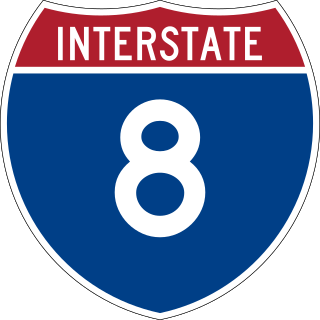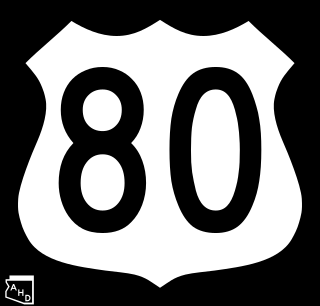
Interstate 8 (I-8) is an Interstate Highway in the southwestern United States. It runs from the southern edge of Mission Bay at Sunset Cliffs Boulevard in San Diego, California, almost at the Pacific Ocean, to the junction with I-10, just southeast of Casa Grande, Arizona. In California, the freeway travels through the San Diego metropolitan area as the Ocean Beach Freeway and the Mission Valley Freeway before traversing the Cuyamaca Mountains and providing access through the Imperial Valley, including the city of El Centro. Crossing the Colorado River into Arizona, I-8 continues through the city of Yuma across the Sonoran Desert to Casa Grande, in between the cities of Phoenix and Tucson.

Interstate 10 (I-10) is the southernmost cross-country highway in the Interstate Highway System. I-10 is the fourth-longest Interstate in the United States at 2,460.34 miles (3,959.53 km), following I-90, I-80, and I-40. This freeway is part of the originally planned network that was laid out in 1956, and its last section was completed in 1990.

Interstate 20 (I‑20) is a major east–west Interstate Highway in the Southern United States. I-20 runs 1,539 miles (2,477 km) beginning at an interchange with I-10 in Scroggins Draw, Texas, and ending at an interchange with I-95 in Florence, South Carolina. Between Texas and South Carolina, I-20 runs through northern Louisiana, Mississippi, Alabama, and Georgia. The major cities that I-20 connects to include Dallas, Texas; Shreveport, Louisiana; Jackson, Mississippi; Birmingham, Alabama; Atlanta, Georgia; and Columbia, South Carolina.

The League of American Bicyclists (LAB), officially the League of American Wheelmen, is a membership organization that promotes cycling for fun, fitness and transportation through advocacy and education. A Section 501(c)(3) nonprofit organization, the League is one of the largest membership organizations of cyclists in the United States.

U.S. Route 80 or U.S. Highway 80 (US 80) is a major east–west United States Numbered Highway in the Southern United States, much of which was once part of the early auto trail known as the Dixie Overland Highway. As the "0" in the route number indicates, it was originally a cross-country route, from the Pacific Ocean to the Atlantic Ocean. Its original western terminus was at Historic US 101 in San Diego, California. However, the entire segment west of Dallas, Texas, has been decommissioned in favor of various Interstate Highways and state highways. Currently, the highway's western terminus is at an interchange with Interstate 30 (I-30) on the Dallas–Mesquite, Texas city line. Its eastern terminus is in Tybee Island, Georgia near the Atlantic Ocean. Between Jonesville, Texas and Kewanee, Mississippi, US 80 runs parallel to or concurrently with Interstate 20. It also currently runs through Dallas, Texas; Shreveport, Louisiana; Jackson, Mississippi; Montgomery, Alabama; Columbus, Georgia; Macon, Georgia; and Savannah, Georgia.

State Route 80 (SR 80) is a 120.20-mile (193.44-kilometre) long, roughly arc-shaped highway lying in southeastern Arizona. Starting in downtown Benson, the highway serves as the main route through the towns of St. David, Tombstone, Bisbee and Douglas before terminating at the New Mexico state line, becoming New Mexico State Road 80 (NM 80). SR 80 also acts as the national southern terminus of US 191 near Douglas and provides the only connection between the U.S. Highway and its business route in Douglas.

The Lee Highway was a national auto trail in the United States, connecting New York City and San Francisco, California, via the South and Southwest. After receiving a letter on January 15, 1919, from Dr. Samuel Myrtle Johnson of Roswell, New Mexico, David Carlisle Humphreys of Lexington, Virginia, put out a call for a meeting in Roanoke, Virginia, to form a new national highway association. On December 3, 1919, five hundred men from five states met in Roanoke to officially form the Lee Highway Association. The auto trail was named after Robert E. Lee.
The Bankhead Highway was a United States cross-country automobile highway connecting Washington, D.C., and San Diego. The Bankhead Highway's beginnings can be traced back to 1916 when the Bankhead Highway Association was organized to promote the highway's development. It was part of the National Auto Trail system. The road was named for Alabama politician John H. Bankhead, a leader in the early national road-building movement. In later years, several stretches of U.S. Route 78 in northwest Alabama were renamed for Bankhead's son, former U.S. Representative and Speaker of the House William B. Bankhead.
State Road 80 (NM 80) is 32.416-mile-long (52.168 km) north–south state road in southwestern New Mexico, between the Arizona state line near Rodeo and Interstate 10 (I-10) at Road Forks. Lying entirely within Hidalgo County, New Mexico, it is the only section of the old U.S. Route 80 (US 80) in New Mexico which still retains its number. The route was re-designated NM 80 in 1989. This is the reason why NM 80 has an even number designation despite the highway being north/south. From the south, SR 80 acts as a continuation of NM 80 into Arizona.

U.S. Route 80 (US 80) is a major U.S. Highway in the American state of Alabama. The Alabama Department of Transportation internally designates the majority of US 80 throughout the state as State Route 8 (SR 8), save for parts of the route throughout Selma and near the Mississippi border. Serving as the main east to west highway through Alabama's Black Belt region, US 80 became well known as the main route for the 1965 Selma to Montgomery marches; it was the route along which the Civil Rights demonstrators walked, from Selma to Alabama, and the Edmund Pettus Bridge in Selma was the site of Bloody Sunday. The highway was also once a major transcontinental highway reaching from Tybee Island, Georgia, to San Diego, California, but has since been truncated to Dallas, Texas because it was largely replaced by the Interstate Highway System.

The Old Spanish Trail was an auto trail that once spanned the United States with almost 2,750 miles (4,430 km) of roadway from ocean to ocean. It crossed eight states and 67 counties along the southern border of the United States. Work on the auto highway began in 1915 at a meeting held at the Battle House Hotel in Mobile, Alabama; and, by the 1920s, the trail linked St. Augustine, Florida, to San Diego, California, with its center and headquarters in San Antonio, Texas. The work at San Antonio, and indeed nationally, was overseen by an executive committee consisting of prominent San Antonio businessmen which met at the Gunter Hotel weekly.

U.S. Route 80 is a U.S. highway that begins in the state of Texas in Dallas at an interchange with I-30. US 80 runs in an east–west direction for most of its length from Dallas to Louisiana. Before the advent of the Interstate Highway System, US 80 through Texas was once a vital link in a major transcontinental highway with the national western terminus being in San Diego, California rather than Dallas. Since 1991, most of US 80 in Texas has been decommissioned in favor of I-10, I-20 and I-30 between the New Mexico state line and its current western terminus.
The Teche Greyhound Lines, a highway-coach carrier, was a Greyhound regional operating company, based in New Orleans, Louisiana, USA, from 1934 until 1954, when it was merged into the Southeastern Greyhound Lines, a neighboring operating company.

U.S. Route 80 (US 80) was a U.S. highway in California that continued east across the country to Georgia. The western terminus of US 80 was in San Diego, California, and it continued east through the city on several different alignments through the years. The highway went through the Cuyamaca Mountains, encountering many switchbacks, before descending to El Centro. After passing through the sand dunes, the highway crossed the Colorado River into Yuma, Arizona.

U.S. Route 80 (US 80) also known as the Ocean-to-Ocean Highway, the Broadway of America and the Jefferson Davis Memorial Highway was a major transcontinental highway that existed in the U.S. state of Arizona from November 11, 1926, to October 6, 1989. At its peak, US 80 traveled from the California border in Yuma to the New Mexico state line near Lordsburg. US 80 was an important highway in the development of Arizona's car culture. Like its northern counterpart, US 66, the popularity of travel along US 80 helped lead to the establishment of many unique road side businesses and attractions, including many iconic motor hotels and restaurants. US 80 was a particularly long highway, reaching a length of almost 500 miles (800 km) within the state of Arizona alone for most of the route's existence.

U.S. Route 80 was a major transcontinental highway in the U.S. state of New Mexico from November 11, 1926, to October 12, 1991. Nationally, US 80 stretched from San Diego, California to Tybee Island, Georgia, going through southern New Mexico from El Paso, Texas, through the towns of Las Cruces, Deming and Lordsburg before entering Arizona. US 80 was a modest 191 miles (307 km) long and was eventually replaced by Interstate 10 leading to the complete removal of US 80 in New Mexico. State Road 80 is a remnant of this route.

A total of ten special routes of U.S. Route 80 exist or did exist in the past.

Ciénega Bridge is an open-spandrel arch bridge which crosses Ciénega Creek and the Union Pacific Railroad near Vail, Arizona. Originally constructed in 1921, the bridge was part of U.S. Route 80, a major transcontinental highway, from 1926 to 1956. Being the oldest bridge of its kind in Arizona, the Ciénega Bridge is listed on the National Register of Historic Places. The bridge also holds the title of being the longest open-spandrel concrete arch bridge within the state. Currently, the bridge carries Marsh Station Road, which is part of Historic U.S. Route 80 as of 2018.
New Mexico State Road 418 is a 14-mile-long (23 km) state-maintained highway in the southwestern corner of New Mexico, running from Interstate 10 (I-10) to an intersection with Spruce Street in Deming. Originally, NM 418 was a section of U.S. Route 80 (US 80), a transcontinental highway running from San Diego, California, to Tybee Island, Georgia, but was bypassed when a new section of US 80 was built between the current western terminus of NM 418 and Pine Street in Deming.
State Road 478 (NM 478) is a 24.342-mile-long (39.175 km) state highway located entirely within Doña Ana County, New Mexico. Starting in Anthony and ending in Las Cruces, NM 478 was once a section of historic US 80, a major transcontinental highway between San Diego, California and Savannah, Georgia. In 1946, it also became part of U.S. Route 85, when the latter highway was extended south to the Mexican border in El Paso, Texas. US 80 and US 85 were rerouted onto a newer alignment to the east in the mid 1950s. This was also around the time the older highway was designated NM 478. For two years, the southern terminus of NM 478 also served as the national western terminus of US 80 until that highway was removed from New Mexico completely in 1991. Today, NM 478 remains on much the same route it has since it was first designated and serves several old US 80/US 85 communities long since bypassed by I-10













